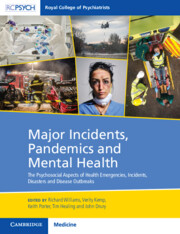 Major Incidents, Pandemics and Mental Health
Major Incidents, Pandemics and Mental Health from Section 2 - Clinical Aspects of Traumatic Injuries, Epidemics, and Pandemics
Published online by Cambridge University Press: 11 January 2024
Infectious diseases that can spread rapidly have always been able to cause outbreaks. Rapid international travel has allowed what were once localised public health issues to extend beyond national borders and develop into global pandemics. The challenges posed by a novel disease may be enormous, and include initial recognition in a previously unexposed population, development of a clinical case definition allowing accurate descriptive epidemiology of its progression in the community, laboratory diagnosis of a novel pathogen, establishment of evidence-based management protocols for patient care, identification of routes of transmission allowing targeted public health interventions, and development of therapeutic interventions to reduce transmission or prevent severe effects. The consequences of large-scale outbreaks extend beyond their direct impact on human health. They may have economic effects as a direct result of illness or of control measures, and impacts on social wellbeing, including damage to national and local infrastructure, civil disruption, or even conflict.
To save this book to your Kindle, first ensure no-reply@cambridge.org is added to your Approved Personal Document E-mail List under your Personal Document Settings on the Manage Your Content and Devices page of your Amazon account. Then enter the ‘name’ part of your Kindle email address below. Find out more about saving to your Kindle.
Note you can select to save to either the @free.kindle.com or @kindle.com variations. ‘@free.kindle.com’ emails are free but can only be saved to your device when it is connected to wi-fi. ‘@kindle.com’ emails can be delivered even when you are not connected to wi-fi, but note that service fees apply.
Find out more about the Kindle Personal Document Service.
To save content items to your account, please confirm that you agree to abide by our usage policies. If this is the first time you use this feature, you will be asked to authorise Cambridge Core to connect with your account. Find out more about saving content to Dropbox.
To save content items to your account, please confirm that you agree to abide by our usage policies. If this is the first time you use this feature, you will be asked to authorise Cambridge Core to connect with your account. Find out more about saving content to Google Drive.